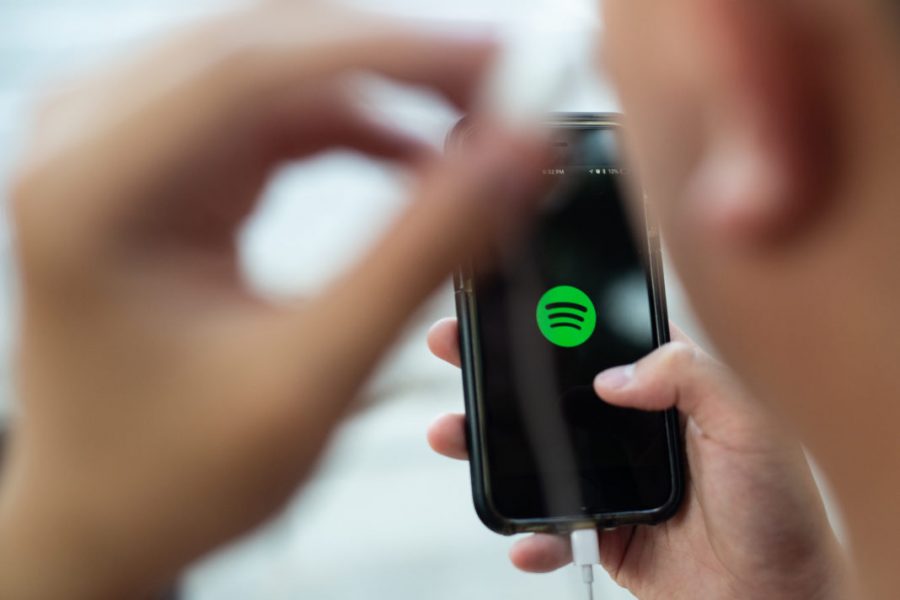The streaming era is wonderful for listeners, but not for artists
(Photo by Justin Prather | The Daily Utah Chronicle).
April 27, 2020
There’s no debating the fact that digital streaming is the primary medium the music industry operates through nowadays. Sure, vinyl and CDs are still very much alive. In fact, vinyl is increasing in popularity almost every year, with 2018 seeing the most vinyl sales since 1988. Physical copies still hold a special appeal — especially if you’re someone like my partner who excitedly collects records for their superior sound quality, or if you’re someone like me whose affinity for CDs stems less from some cool musical sentiment and more from my 2005 Altima having no aux port.
But even those who choose to listen to records and CDs still tend to treat Spotify or Apple Music as their go-to. There’s something so intentional about listening to music on physical copies — in other words, it isn’t our default. As I write this article, I’m not rummaging through my limited CD collection — I’m flipping between the infinite options Spotify offers me (sometimes letting it tell me what I want to hear because it knows better than I do). It’s clear that streaming services have ushered in a new era of music consumption, one more convenient and accessible than ever — especially since most memberships cost around $10/month instead of that horrifying $1.29 per song download we once had to endure.
Out With the Old, In With the New
The meteoric rise of online music streaming services, beginning with Last.fm and Pandora, and eventually evolving into the modern juggernauts of the industry, Spotify and Apple Music, begs some questions we may not consider often. How exactly can these companies afford to offer virtually everything ever released by a recording studio, while charging so little per song? Don’t get me wrong, I’m not arguing that my Spotify membership should be more expensive, but I’ve begun to wonder who exactly footed the bill for this dramatic shift in music distribution.
When it comes to artists’ end of the deal in the streaming era, it’s pretty complicated. It’s true that, as proponents of the streaming industry like to remind us, Spotify has done great things for the world of music. Now, singers and songwriters don’t necessarily need deals with big labels to have their music released for anyone on the planet to hear. Streaming services have far outpaced digital downloads, which were once hailed as the innovation to compensate for declining CD sales. But digital piracy became too easy to resist, usurping the first decade of the 2000s— causing artists to experience plummeting revenues. The integration of online streaming services into everyday culture has certainly rescued music revenue, but now, where does all that revenue go?
How Artists Are Paid
It turns out that Spotify pays a song rights holder anywhere from $0.006 to $0.0084 per stream, with top-streaming artists earning the higher rates in what’s called the “pro rata” model. This means that one million Spotify streams generates, on average, about $7,000. This figure might not sound too low until we consider just how many artists rarely, if ever, top a million streams, in addition to the fact that those profits are funneling first and foremost into the record label, secondarily to producers and lastly to singers, band members and lyricists. This system often leaves the artists, whose content is what’s bringing in any customers to begin with, seriously short-changed.
In addition to the push for streaming services to simply increase their royalty payments — which has been met with serious resistance — another proposed solution is the replacement of the pro-rata model with a “user-centric” model. Rather than taking your monthly payment and divvying it up between the highest-streamed celebrities, Spotify would instead distribute the profits according to your own personal streams. A study by Digital Media Finland found currently, Spotify pays the top 0.4% of artists almost 10% of the total distributed revenue, but under the user-centric structure, that portion drops to 5.6%, resulting in a “remarkable” payment increase for those countless artists with fewer streams.
Although a shift to the user-centric model could be costly and tricky to implement, artists and music rights groups are increasingly vocalizing their support for it, and I see where they’re coming from. I’d definitely prefer knowing that my Spotify streams are supporting up-and-coming creators rather than funding another multi-million-dollar fallout shelter for Post Malone to use twice a year when he visits Utah.
Supporting Artists
There may not be much everyday listeners can do to sway the decision-making of huge corporations like Spotify and Apple Music, but that doesn’t mean we’re powerless when it comes to supporting the creators who improve our quality of living. As consumers of music, the most influence we have is to show up for our favorite artists when they come to venues near us — when or if we have the means to do so. I especially love purchasing merchandise from smaller bands or openers, since my dollars will go much farther for a t-shirt from them over the mall or an online retailer.
A great opportunity to support our local music community here in Salt Lake City is currently being offered by Kilby Court, a venue that’s instantly cherished by anyone who visits. By donating to them now in this time of need, you will receive a credit for future ticket or merchandise purchases. See their Instagram post for details.








